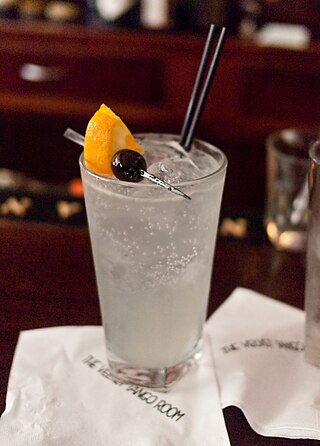
The Tom Collins is a Collins cocktail made from gin, lemon juice, sugar, and carbonated water. First memorialized in writing in 1876 by Jerry Thomas, "the father of American mixology", this "gin and sparkling lemonade" drink is typically served in a Collins glass over ice. A non-alcoholic "Collins mix" mixer is produced, enjoyed by some as a soft drink.

The Singapore sling is a gin-based sling cocktail from Singapore. This long drink was developed sometime before 1915 by Ngiam Tong Boon, a bartender at the Long Bar in Raffles Hotel, Singapore. It was initially called the gin sling.
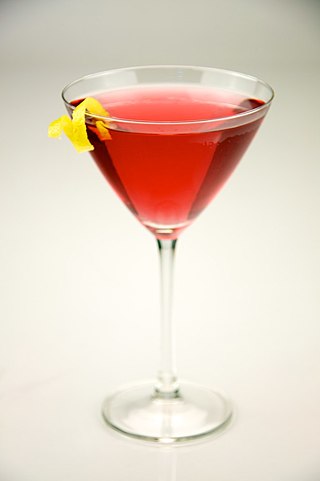
A cosmopolitan, or, informally, a cosmo, is a cocktail made with vodka, Cointreau, cranberry juice, and freshly squeezed or sweetened lime juice.

A stinger is a duo cocktail made by adding crème de menthe to brandy. The cocktail's origins can be traced to the United States in the 1890s, and the beverage remained widely popular in America until the 1970s. It was seen as a drink of the upper class, and has had a somewhat wide cultural impact.

A sour is a traditional family of mixed drinks. Sours belong to one of the old families of original cocktails and are described by Jerry Thomas in his 1862 book How to Mix Drinks.

White lady is a classic cocktail that is made with gin, cointreau or Triple Sec, fresh lemon juice and an optional egg white. It belongs to the sidecar family, made with gin in place of brandy. The cocktail sometimes also includes additional ingredients, for example egg white, sugar, cream, or creme de menthe.
A Scorpion Bowl is a communally shared alcoholic tiki drink served in a large ceramic bowl traditionally decorated with wahine or hula-girl island scenes and meant to be drunk through long straws. Bowl shapes and decorations can vary considerably. Starting off as a single-serve drink known as the Scorpion cocktail, its immense popularity as a bowl drink in tiki culture is attributed to Trader Vic.

The Fine Art of Mixing Drinks is a book about cocktails by David A. Embury, first published in 1948. The book is noteworthy for its witty, highly opinionated and conversational tone, as well as its categorization of cocktails into two main types: aromatic and sour; its categorization of ingredients into three categories: the base, modifying agents, and special flavorings and coloring agents; and its 1:2:8 ratio for sour type cocktails.
The brandy daisy is a cocktail which first gained popularity in the late 19th century. One of the earliest known recipes was published in 1876 in the second edition of Jerry Thomas's The Bartenders Guide or How To Mix Drinks: The Bon-Vivants Companion:
Fill glass half full of shaved ice. Shake well and strain into a glass, and fill up with Seltzer water from a syphon.

A "fizz" is a mixed drink variation on the older sours family of cocktail. Its defining features are an acidic juice and carbonated water. It typically includes gin or rum as its alcoholic ingredient.
The 20th century is a cocktail created in 1937 by a British bartender named C.A. Tuck, and named in honor of the celebrated 20th Century Limited train which ran between New York City and Chicago from 1902 until 1967. The recipe was first published in 1937 in the Café Royal Cocktail Book by William J Tarling, President of the United Kingdom Bartenders' Guild and head bartender at the Café Royal.

A sea breeze is a cocktail containing vodka with cranberry juice and grapefruit juice. The cocktail is usually consumed during summer months. The drink may be shaken in order to create a foamy surface. It is considered an IBA Official Cocktail.
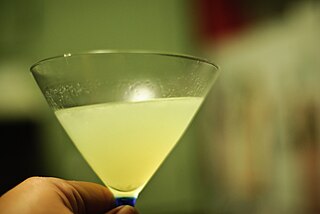
The Last Word is a gin-based cocktail originating at the Detroit Athletic Club in the 1910s, shortly before the start of Prohibition. After a long period of obscurity, it enjoyed a renewed popularity in the early 2000s when it was introduced at the Zig Zag Café in Seattle.

The aviation is a cocktail made with gin, maraschino liqueur, crème de violette and lemon juice. Some recipes omit the crème de violette. It is served straight up, in a cocktail glass.
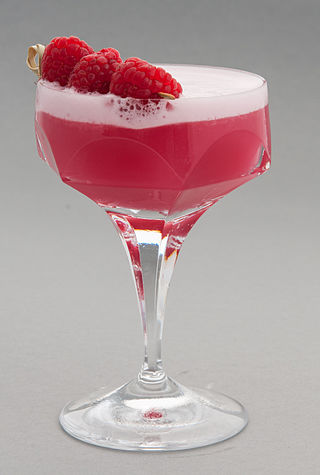
A Clover Club cocktail is a shaken cocktail consisting of gin, lemon juice, raspberry syrup, and egg white. The egg white acts as an emulsifier, forming the drink's characteristic foamy head.
The corpse reviver family of named cocktails are sometimes drunk as alcoholic hangover tongue-in-cheek "cures", of potency or characteristics to be able to revive even a dead person. Some corpse reviver cocktail recipes have been lost to time, but several variations commonly thought to be tied to the American Bar at the Savoy Hotel remain, especially those espoused by Harry Craddock that originally date back to at least 1930 and are still being made. Many "reviver" variations exist and the word is sometimes used as a generic moniker for any morning-after cocktail, also known as a "hair of the dog".

The doctor cocktail is a pre-prohibition era cocktail that traces in drink guides to as far back as 1917, when it appeared in Hugo R. Ensslin's Recipes for Mixed Drinks. As originally described the cocktail called simply for Swedish Punsch mixed with lime juice.
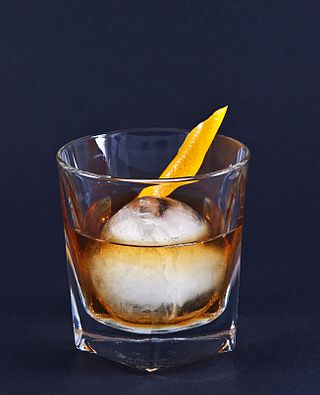
A whiskey cocktail is a cocktail that includes whiskey. Although whiskey is often served neat or on the rocks, it is used in many classic cocktails such as the Old Fashioned, Manhattan, and Julep. Some specifically call for Scotch whisky or bourbon whiskey.
















